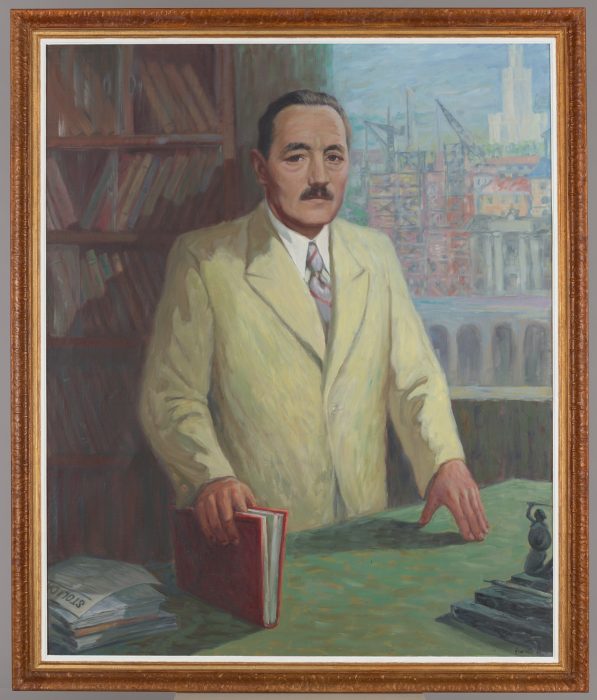
Official portrait of Bolesław Bierut (1892–1956)
The portrait shows the first leader of the Polish People’s Republic and the Polish United Workers’ Party which held real power in the country between 1948 and 1989, against the backdrop of Warsaw amidst reconstruction efforts. In the postwar history of Poland, Bolesław Bierut (1892–1956) became a symbol of the Iron Curtain and the Stalinist Terror. Yet, it is impossible to erase that figure from history as it provides the key to understanding the contemporary Warsaw and its phenomena: the reconstructed Old Town which had been destroyed entirely during World War II, the chaotic urban development of the city centre, the controversies that surround the current reprivatisation of Warsaw properties nationalized after World War II pursuant to the Bierut Decree as of 1945 (the Municipality of Warsaw took over the land within the boundaries of the city, which was supposed to facilitate its reconstruction). The Socialist Realist portrait by Michał Gawlak (1906–1971) addresses these questions indirectly and, above all, bears testimony to the role of the rebuilding of the capital city in the propaganda of the period.
Behind Bierut’s back opens a view of modern Warsaw, yet it is a fantastic cityscape. The painter wanted to demonstrate several of Bierut’s achievements at a time, which would not be possible if a realistic panorama was to be rendered. Seen behind the facade of the Branicki Palace, undergoing reconstruction, is a view of the bright edifice of the Palace of Culture and Science, a “gift” from Joseph Stalin (1878–1953) for Warsaw.
The Palace stood as a symbol of the reborn modern capital of the Communist country. Bearing reference to Warsaw are also two objects on the desk in front of Bierut: a statuette of the Mermaid and a copy of Stolica magazine, which provided a detailed account of the city reconstruction.
The portrait is interesting for yet another reason: it is likely the last official portrait in the history of Polish painting that makes a conscious use of the tradition of the images of rulers. Tapping into historic models, particularly from the epochs of Renaissance and Classicism, was a characteristic feature of the Socialist Realist period, both in visual arts and in architecture. Here, it can be seen in the manner of portraying the monumental figure akin to a Renaissance prince, in an interior with attributes of enlightened power, such as the bookshelf, the book and the city under construction visible through the window.
The portrait was donated to the Historical Museum of the City of Warsaw (today’s Museum of Warsaw) in 1964. The donor was the Small Manufacturing Committee, established two years after Bierut’s death. In all likelihood, the painting arrived there from the Ministry of Small Industry and Handicraft, closed in 1958 with the Committee established instead. The portrait was likely one of the official, monumental images of Bierut exhibited at the most important state offices and institutions.
Official portrait of Bolesław Bierut (1892–1956)
MICHAŁ GAWLAK
WARSAW; C. 1955
OIL ON CANVAS
MHW 15138
165 × 136 CM
Image licensed under: ![]()
